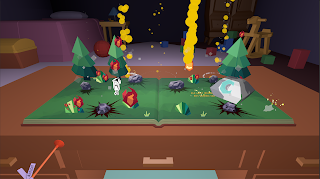The whole Bookend team has never worked on a VR project nor have ever been avid
VR connoisseurs up until the creation of Bookend.
 |
| "a pop-up book" in VR |
What we did know, however, was
that we wanted to create a unique, well-designed project meant to wow everybody
within the University of California: Santa Cruz’s capstone series.
This idea was two-fold: first, it was supported by the fact that many of us believe that virtual reality as a concept is only budding. We have yet to see the huge mainstream appeal of virtual reality and the technology is only going to improve. We, as the Bookend team, want to be there for the ride (and get a portfolio boost). Second of which, virtual reality was a means for us to truly create an immersive experience allowing the designers within the group to truly flex their design muscles, and the developers to experience developing with virtual reality in mind.
In an attempt to explore this idea, we began iterating on Beloved, an atmospheric horror
game set within a virtual reality space. We iterated ideas over the course of a couple
months such as the player having ghost hands and using telekinesis to guide another
individual around puzzle situations akin to a second person exploration game. Although
the game was only supposed to take place within a household, the project quickly got
out of scope within its narrative, art direction, and programming months into our
development cycle.
 |
| Winning the the Peer Choice Award |
We persevered through months of dead-end conceptualization, eventually leading us to
create a narrative-centric puzzle game meant to subvert the expected conventions (grab
objects and throw stuff) within a virtual reality space. Although started by a core team of
ten students for Beloved, we quickly ballooned our team into twenty (ten core members
and ten auxiliary members that helped with art, sound/music, and programming) for
Bookend’s rise.
We definitely wanted the gameplay to be reminiscent of reading through a pop-up book
so heavy design iteration went into honing in on that particular feeling. As such, many of
our mechanics are analogous to the features of a physical pop-up book. The music and
narrative direction, in particular, serve to enhance the whimsical and enchanting nature
of Bookend’s aesthetic.
 Creating Bookend was not without its problems, however, as developing through the
affordances of VR. We ran through multiple problems that the affordances of a mouse
and keyboard avoided. Namely, controls were our number one issue. We changed our
controls scheme multiple times due to player confusion with the Oculus controls. At first,
we had it so that the player navigated the game space with their headset, looking at
objects they wanted to interact with. We quickly realized that this idea was more trouble
than what it was worth. Players quickly grew frustrated at the fact that they had to
pinpoint their headset at a small object in order to select it.
Creating Bookend was not without its problems, however, as developing through the
affordances of VR. We ran through multiple problems that the affordances of a mouse
and keyboard avoided. Namely, controls were our number one issue. We changed our
controls scheme multiple times due to player confusion with the Oculus controls. At first,
we had it so that the player navigated the game space with their headset, looking at
objects they wanted to interact with. We quickly realized that this idea was more trouble
than what it was worth. Players quickly grew frustrated at the fact that they had to
pinpoint their headset at a small object in order to select it.
We then changed the
controls to focus on the Oculus Touch.
 |
| Bookend Team |
Our first iteration of this was too focused on the
Oculus face buttons (A, B, X, Y). We had players press the grip button on the controller
and confirm their selection with either A or X. This caused the issue of the player not
knowing which button was A or X causing them to become increasingly confused and
frustrated. Through a lengthy design discussion, we finally decided to change the
controls to what we have now: Point in VR by closing the grip button and confirm the
selection with the trigger button. This was due to the fact that the grip and trigger
buttons are the largest buttons on an Oculus Touch controller. This changed proved
beneficial as when players would get confused about the controls, they would first
attempt to press the trigger and grip buttons.
Wanting to create a project that mattered to us, the team decided to make a VR
project that doubled down on immersion and unique gameplay features. Developing
through VR is difficult, especially in the controls department. (Try getting someone to
press the A button while they can’t see!) Nonetheless, through multiple months of hard,
dedicated work, Bookend slowly yet steadily transitioned from a concept born from the
fall of Beloved into a concept that carried its own weight. The last-minute scrapping of
our original idea left our team scrambling, but we’re extremely proud with our work thus
far.
We hope that you enjoy playing through Bookend as much as we enjoyed making it.

No comments:
Post a Comment